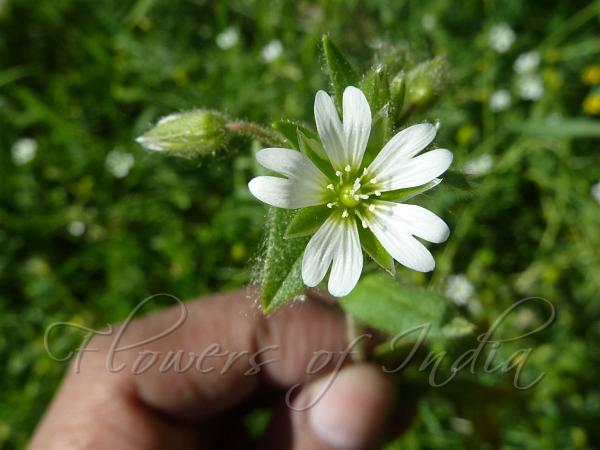|
| Common Mouse-Ear Chickweed |
|

|

| File size | 307586 |
| Original date | 6/28/12 3:29 PM |
| Resolution | 2560 x 1920 |
| Flash | Flash did not fire, auto |
| Focal length | 4.1mm |
| Exposure time | 1/400s |
| Aperture | 5.0 |
| Focus Distance | |
| Metering Mode | Multi-segment |
| Camera make | Panasonic |
| Camera model | DMC-TZ10 |
| Sensor type | OneChipColorArea |
|
|
|
|
Photo: |
Botanical name: Cerastium holosteoides Family: Caryophyllaceae (Carnation family)
Synonyms: Cerastium fontanum subsp. holosteoides, Cerastium vulgatum var. tibeticum, Cerastium fontanum subsp. vulgare
Synonyms: Cerastium fontanum subsp. holosteoides, Cerastium vulgatum var. tibeticum, Cerastium fontanum subsp. vulgare
Common mouse-ear chickweed is a biennial or
short-lived perennial plant that grows from a taproot. Flowering stems
are prostrate, root at the nodes, and form clumps up to 38 cm across.
Stems are 5 to 38 cm long and are covered with stiff, glandular hairs.
Stem leaves are opposite, lanceshaped to ovate, up to 2.5 cm long,
single-nerved, and coarsely hairy on both surfaces. Leaves of the
flowering stems are larger, up to 4 cm long. Commonly, several to many
flowers are arranged in open clusters. Flowers are small, erect or
spreading, and inprominent. Each flower is composed of five white,
two-cleft petals. Petals are about 6 mm long and equal or nearly equal
to the sepals. Sepals are hairy with papery margins. Capsules are
cylindrical, 10-valved, and up to 13 mm long. Common Mouse-Ear
Chickweed is found in Temp. & Subarctic Eurasia to W Himalaya to New
Guinea. In the Himalayas it is found at 3000 m and above, common in
Ladakh.
| Identification credit: Tabish | Photographed in Nubra Valley, Ladakh. |
• Is this flower misidentified? If yes,